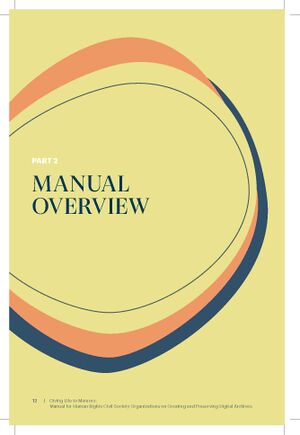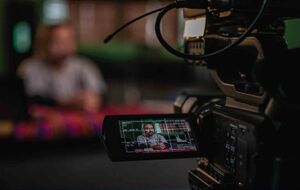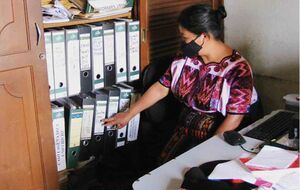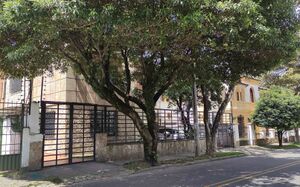Manual Overview: Difference between revisions
No edit summary |
(Marked this version for translation) Tag: Manual revert |
||
| (18 intermediate revisions by 2 users not shown) | |||
| Line 1: | Line 1: | ||
[[File:Manual Overview.jpg|thumb|435x435px]] | <languages/> | ||
[[File:<translate><!--T:65--> Manual Overview.jpg</translate>|thumb|<translate><!--T:33--> 435x435px</translate>]] | |||
<translate> | |||
== Basic Concepts == | == Basic Concepts == <!--T:34--> | ||
<!--T:35--> | |||
The purpose of this manual is to be an instructional and practical guide to digital archiving for CSOs. | |||
<!--T:36--> | |||
Digital archiving is the process of creating, managing, and developing [[Special:MyLanguage/Glossary of Key Terms and Concepts#Digital Archives|'''digital archives''']]. For the purposes of this manual, digital archives are defined as archives that contain material in a digital form—including both [[Special:MyLanguage/Glossary of Key Terms and Concepts#Born-digital|'''born-digital''']] items and digitized versions of originally physical material—stored on digital media and managed through digital tools. | |||
It is important to underline, however, that | <!--T:37--> | ||
It is important to underline, however, that digital archives are still archives containing documents or other material, albeit in a digital form, that needs to be organized, described, arranged, stored, safeguarded, and accessible to users. Therefore, in many ways, digital archives are just like any physical archive, requiring the application of the same basic [[Special:MyLanguage/Glossary of Key Terms and Concepts#Archival rules|'''archival rules''']], [[Special:MyLanguage/Glossary of Key Terms and Concepts#Archival Techniques|'''techniques''']], and actions. In this sense, there is a significant overlap between the [[Special:MyLanguage/Glossary of Key Terms and Concepts#Guiding Principles|'''Guiding Principles''']], methods, and work needed to create both a physical and a digital archive. | |||
Nevertheless, archival work with digital material, tools, and resources also brings a new layer of requirements, considerations, and challenges. From | <!--T:38--> | ||
Nevertheless, archival work with digital material, tools, and resources also brings a new layer of requirements, considerations, and challenges. From planning the archive and organizing the material to decisions on its [[Special:MyLanguage/Glossary of Key Terms and Concepts#Description of Archival Material|'''description''']] and arrangement, use of specific software, managing storage, and defining modes of access, digital archiving adds a different spin to the archival process. It requires a somewhat different [[Special:MyLanguage/Glossary of Key Terms and Concepts#Active and Passive Approach|'''approach''']] and an additional set of [[Special:MyLanguage/Glossary of Key Terms and Concepts#Archival Techniques|'''archival techniques''']]. It is precisely these specific aspects of digital archiving work that this manual addresses outlines, and guides for. | |||
The following are reasons why this manual focuses specifically on | <!--T:39--> | ||
The following are reasons why this manual focuses specifically on digital archiving. | |||
[[File:CSOs-in-Digital-Archiving-Toolkit-6x9-EN-final-print (KEY WORDS WIKI) Page 015.jpg|thumb|Image shared by CONAVIGUA, GIJTR partner organization in Guatemala.]] | |||
</translate> | |||
[[File:CSOs-in-Digital-Archiving-Toolkit-6x9-EN-final-print (KEY WORDS WIKI) Page 015.jpg|thumb|<translate><!--T:40--> Image shared by CONAVIGUA, GIJTR partner organization in Guatemala.</translate>]] | |||
<translate> | |||
== Why a Manual on Digital Archiving? == | == Why a Manual on Digital Archiving? == <!--T:41--> | ||
''' | <!--T:42--> | ||
[[Special:MyLanguage/Glossary of Key Terms and Concepts#Born-digital|'''Born-digital''']] and digitized physical materials have become widely present in archives created and developed by CSOs dealing with human rights abuses. Moreover, physical archival material can be preserved and secured only through [[Special:MyLanguage/Glossary of Key Terms and Concepts#Digitization|'''digitization''']] and by making digital copies a part of the digital archives. Another growing need for digital archives arises from the often excessive amount of material that needs to be archived and preserved long-term. Thus, the only feasible way of storing and preserving it is through digitization and creating a digital archive. | |||
<!--T:43--> | |||
Digital archives can also provide immensely improved internal and external access to content and the possibility to search, identify, manage, review, or copy any item in the [[Special:MyLanguage/Glossary of Key Terms and Concepts#Collection|'''collection''']]. This, in turn, opens completely new horizons—regarding the potential for digital archival material to be used for outreach, educational, or memorialization purposes. | |||
<!--T:44--> | |||
To successfully preserve the memory of the past by creating archives today, we must always bear in mind their future users. We should be mindful that the archival work and solutions we apply must be communicable and transferable to those who will use it in the future to sustain our archives long-term. To ensure this “future-proof” quality of our archives, we must use tested and proven digital tools, formats, and resources to manage and archive [[Special:MyLanguage/Glossary of Key Terms and Concepts#Born-digital|'''born-digital''']] and digitized archival material. | |||
</translate> | |||
[[File:CSOs-in-Digital-Archiving-Toolkit-6x9-EN-final-print (KEY WORDS WIKI) Page 017.jpg|thumb|<translate><!--T:45--> Image shared by Conavigua, GIJTR partner organization in Guatemala.</translate>]] | |||
<translate> | |||
<!--T:46--> | |||
For all these reasons, among CSOs working with material on human rights violations, there is a concrete and growing need for information and resources on digital archiving—including a manual such as this one. On the one hand, digital archiving of such material is quickly becoming a necessity for these organizations. On the other hand, CSOs often lack the necessary knowledge and skills for the creation and development of digital archives and would, therefore, benefit from a resource that provides structured guidance through the process and an overview of challenges, tips, and best practices. While there are already very good Manuals available dealing with different aspects of physical archiving, there is no systematized yet practice-based and practice-oriented guide for CSOs addressing the entire digital archiving process. | |||
This | <!--T:47--> | ||
This gap has been identified by the Global Initiative for Justice, Truth, and Reconciliation (GIJTR)—a consortium of nine global organizations that work together to assist communities in, or are emerging from, conflict in creating just and peaceful futures. To address the growing need for CSOs for information resources, [[Special:MyLanguage/Means and Resources for building a digital archive#Capacity building and Networking|'''capacity''']] building, and networking in digital archiving, in 2021, five organizations—members of the GIJTR consortium—initiated the project “Supporting CSOs in Digital Archiving.” | |||
<!--T:48--> | |||
This manual is a result of this project. It was conceptualized, devised, and developed based on research, exchanges, and knowledge gathered throughout this two-year project. It is grounded in and built on the experiences and insights of more than 40 CSOs from 24 different countries that provided their input and participated in this project. | |||
== Framework for the Manual: “Supporting CSOs in Digital Archiving” Project == <!--T:49--> | |||
The | <!--T:50--> | ||
The “Supporting CSOs in Digital Archiving” project was designed to aid civil society actors in creating and utilizing digital archives to support transitional justice mechanisms and advance the broader transitional justice goals of truth-telling, justice and accountability, memorialization, and non-recurrence. | |||
<!--T:51--> | |||
The project was implemented in two stages over two years by five organizations/members of the GIJTR consortium. The project leader was the [http://www.hlc-rdc.org/?lang=de '''Humanitarian Law Centre (HLC)'''] from Serbia, and the consortium included [https://www.sitesofconscience.org/ '''The International Coalition of Sites of Conscience (ICSC)'''] from the USA, [https://www.publicinternationallawandpolicygroup.org/ '''The Public International Law & Policy Group (PILPG)'''] from the USA, the [https://www.dccam.org/ '''Documentation Center of Cambodia (DC-Cam)'''], and [https://fafg.org/en/ '''Forensic Anthropology Foundation of Guatemala (FAFG)''']. | |||
<!--T:52--> | |||
The project’s goals were to increase understanding and knowledge of the digital archiving-related challenges, needs, and practices of CSOs dealing with mass human rights violations; to facilitate networking and exchange of experiences and lessons learned between them; to increase their [[Special:MyLanguage/Means and Resources for building a digital archive#Capacity building and Networking|'''capacity''']] for digital archiving; and to develop practical resources on digital archiving that respond to the CSOs’ varied needs. | |||
<!--T:53--> | |||
To these aims, GIJTR partners designed and disseminated two questionnaires: one aimed at assessing the digital archiving-related needs and practices of CSOs that are only starting to develop their digital archives, and the other to gather information on best practices as well as challenges encountered by CSOs that are already advanced in the process of digital archiving. Responses to these two questionnaires, either in written form or through interviews, have been collected from more than 40 relevant CSOs spanning three continents—from Japan to Croatia. | |||
</translate> | |||
[[File:CSOs-in-Digital-Archiving-Toolkit-6x9-EN-final-print (KEY WORDS WIKI) Page 019.jpg|thumb|<translate><!--T:54--> Image shared by AVIPA, GIJTR partner organization in Guinea.</translate>]] | |||
<translate> | |||
<!--T:55--> | |||
The first project phase also included a three-day virtual dialogue on digital archiving needs and best practices for CSOs, with the participation of GIJTR consortium members and many organizations that provided their input through questionnaires and interviews. During this phase, the partners also reviewed the existing literature on digital archiving for CSOs and gathered and made the identified relevant resources readily available. | |||
<!--T:56--> | |||
In the project's second stage, relying on the analysis of, and findings from, the questionnaires and interviews with CSOs, as well as the insights gathered from the exchanges held as part of the project’s virtual dialogue, GIJTR consortium members developed a framework for this manual. Hence, the experiences, practices, challenges, and needs of CSOs with hands-on experience in digital archiving make up the foundation of this manual, are its primary source of material, and guide the selection of topics and issues it addresses. | |||
<!--T:57--> | |||
Moreover, a draft version of this manual was used by four selected CSOs to guide the implementation of their respective pilot projects in digital archiving: | Moreover, a draft version of this manual was used by four selected CSOs to guide the implementation of their respective pilot projects in digital archiving: | ||
<!--T:58--> | |||
* “The Association of Relatives and Friends of the Events of September 28, 2009” (AVIPA, Guinea); | * “The Association of Relatives and Friends of the Events of September 28, 2009” (AVIPA, Guinea); | ||
* “The National Coordination of Widows of Guatemala” (CONAVIGUA); | * “The National Coordination of Widows of Guatemala” (CONAVIGUA); | ||
| Line 52: | Line 84: | ||
* “Colombian Commission of Jurists” (CCJ). | * “Colombian Commission of Jurists” (CCJ). | ||
Following six months of pilot project implementation and using a draft of this | <!--T:59--> | ||
Following six months of pilot project implementation and using a draft of this manual as a guide, the feedback provided by these organizations has been incorporated and used to improve the final version of the manual to make it as useful as possible to CSOs in their daily digital archiving work. | |||
== Purpose and Structure of the Manual == <!--T:60--> | |||
<!--T:61--> | |||
As the purpose of this manual is to be an informative and practical guide to digital archiving and creating digital archives, it relies on examples and best practices collected from GIJTR Consortium members and partners. It is structured in a way that makes it useful to a broad scope of human rights organizations, both those that are only beginning this process as well as CSOs working to maintain and further develop their digital archives. | |||
</translate> | |||
[[File:CSOs-in-Digital-Archiving-Toolkit-6x9-EN-final-print (KEY WORDS WIKI) Page 021.jpg|thumb|<translate><!--T:62--> Image shared by CCJ, GIJTR partner organization in Colombia</translate>]] | |||
<translate> | |||
<!--T:63--> | |||
The manual combines current expert knowledge and insights from digital archiving with the perspective of human rights organizations worldwide and their specific needs, challenges, and best practices in this field. It draws on the direct experiences of CSOs who took part in the project and shared their views through detailed questionnaires, exchanges, and discussions. | |||
From the decision to create a '''Digital Archiving System''' through its establishment and development to its continuous change, adaptation, and [[Glossary of Key Terms and Concepts#Active Maintenance|maintenance]], the | <!--T:64--> | ||
From the decision to create a [[Special:MyLanguage/Glossary of Key Terms and Concepts#Digital Archiving System|'''Digital Archiving System''']] through its establishment and development to its continuous change, adaptation, and [[Special:MyLanguage/Glossary of Key Terms and Concepts#Active Maintenance|'''maintenance''']], the manual acts as a guide throughout the process. Various organizations reading and using it will be at different points of their digital archive life cycles. Therefore, while the manual is written to assist through the entire life cycle, it is also designed to allow for using separate chapters as standalone sources for informing specific phases of digital archiving work. | |||
</translate> | |||
Latest revision as of 09:57, 11 March 2024

Basic Concepts
The purpose of this manual is to be an instructional and practical guide to digital archiving for CSOs.
Digital archiving is the process of creating, managing, and developing digital archives. For the purposes of this manual, digital archives are defined as archives that contain material in a digital form—including both born-digital items and digitized versions of originally physical material—stored on digital media and managed through digital tools.
It is important to underline, however, that digital archives are still archives containing documents or other material, albeit in a digital form, that needs to be organized, described, arranged, stored, safeguarded, and accessible to users. Therefore, in many ways, digital archives are just like any physical archive, requiring the application of the same basic archival rules, techniques, and actions. In this sense, there is a significant overlap between the Guiding Principles, methods, and work needed to create both a physical and a digital archive.
Nevertheless, archival work with digital material, tools, and resources also brings a new layer of requirements, considerations, and challenges. From planning the archive and organizing the material to decisions on its description and arrangement, use of specific software, managing storage, and defining modes of access, digital archiving adds a different spin to the archival process. It requires a somewhat different approach and an additional set of archival techniques. It is precisely these specific aspects of digital archiving work that this manual addresses outlines, and guides for.
The following are reasons why this manual focuses specifically on digital archiving.

Why a Manual on Digital Archiving?
Born-digital and digitized physical materials have become widely present in archives created and developed by CSOs dealing with human rights abuses. Moreover, physical archival material can be preserved and secured only through digitization and by making digital copies a part of the digital archives. Another growing need for digital archives arises from the often excessive amount of material that needs to be archived and preserved long-term. Thus, the only feasible way of storing and preserving it is through digitization and creating a digital archive.
Digital archives can also provide immensely improved internal and external access to content and the possibility to search, identify, manage, review, or copy any item in the collection. This, in turn, opens completely new horizons—regarding the potential for digital archival material to be used for outreach, educational, or memorialization purposes.
To successfully preserve the memory of the past by creating archives today, we must always bear in mind their future users. We should be mindful that the archival work and solutions we apply must be communicable and transferable to those who will use it in the future to sustain our archives long-term. To ensure this “future-proof” quality of our archives, we must use tested and proven digital tools, formats, and resources to manage and archive born-digital and digitized archival material.

For all these reasons, among CSOs working with material on human rights violations, there is a concrete and growing need for information and resources on digital archiving—including a manual such as this one. On the one hand, digital archiving of such material is quickly becoming a necessity for these organizations. On the other hand, CSOs often lack the necessary knowledge and skills for the creation and development of digital archives and would, therefore, benefit from a resource that provides structured guidance through the process and an overview of challenges, tips, and best practices. While there are already very good Manuals available dealing with different aspects of physical archiving, there is no systematized yet practice-based and practice-oriented guide for CSOs addressing the entire digital archiving process.
This gap has been identified by the Global Initiative for Justice, Truth, and Reconciliation (GIJTR)—a consortium of nine global organizations that work together to assist communities in, or are emerging from, conflict in creating just and peaceful futures. To address the growing need for CSOs for information resources, capacity building, and networking in digital archiving, in 2021, five organizations—members of the GIJTR consortium—initiated the project “Supporting CSOs in Digital Archiving.”
This manual is a result of this project. It was conceptualized, devised, and developed based on research, exchanges, and knowledge gathered throughout this two-year project. It is grounded in and built on the experiences and insights of more than 40 CSOs from 24 different countries that provided their input and participated in this project.
Framework for the Manual: “Supporting CSOs in Digital Archiving” Project
The “Supporting CSOs in Digital Archiving” project was designed to aid civil society actors in creating and utilizing digital archives to support transitional justice mechanisms and advance the broader transitional justice goals of truth-telling, justice and accountability, memorialization, and non-recurrence.
The project was implemented in two stages over two years by five organizations/members of the GIJTR consortium. The project leader was the Humanitarian Law Centre (HLC) from Serbia, and the consortium included The International Coalition of Sites of Conscience (ICSC) from the USA, The Public International Law & Policy Group (PILPG) from the USA, the Documentation Center of Cambodia (DC-Cam), and Forensic Anthropology Foundation of Guatemala (FAFG).
The project’s goals were to increase understanding and knowledge of the digital archiving-related challenges, needs, and practices of CSOs dealing with mass human rights violations; to facilitate networking and exchange of experiences and lessons learned between them; to increase their capacity for digital archiving; and to develop practical resources on digital archiving that respond to the CSOs’ varied needs.
To these aims, GIJTR partners designed and disseminated two questionnaires: one aimed at assessing the digital archiving-related needs and practices of CSOs that are only starting to develop their digital archives, and the other to gather information on best practices as well as challenges encountered by CSOs that are already advanced in the process of digital archiving. Responses to these two questionnaires, either in written form or through interviews, have been collected from more than 40 relevant CSOs spanning three continents—from Japan to Croatia.

The first project phase also included a three-day virtual dialogue on digital archiving needs and best practices for CSOs, with the participation of GIJTR consortium members and many organizations that provided their input through questionnaires and interviews. During this phase, the partners also reviewed the existing literature on digital archiving for CSOs and gathered and made the identified relevant resources readily available.
In the project's second stage, relying on the analysis of, and findings from, the questionnaires and interviews with CSOs, as well as the insights gathered from the exchanges held as part of the project’s virtual dialogue, GIJTR consortium members developed a framework for this manual. Hence, the experiences, practices, challenges, and needs of CSOs with hands-on experience in digital archiving make up the foundation of this manual, are its primary source of material, and guide the selection of topics and issues it addresses.
Moreover, a draft version of this manual was used by four selected CSOs to guide the implementation of their respective pilot projects in digital archiving:
- “The Association of Relatives and Friends of the Events of September 28, 2009” (AVIPA, Guinea);
- “The National Coordination of Widows of Guatemala” (CONAVIGUA);
- “The Association of Relatives of the detained and disappeared of Guatemala” (FAMDEGUA);
- “Colombian Commission of Jurists” (CCJ).
Following six months of pilot project implementation and using a draft of this manual as a guide, the feedback provided by these organizations has been incorporated and used to improve the final version of the manual to make it as useful as possible to CSOs in their daily digital archiving work.
Purpose and Structure of the Manual
As the purpose of this manual is to be an informative and practical guide to digital archiving and creating digital archives, it relies on examples and best practices collected from GIJTR Consortium members and partners. It is structured in a way that makes it useful to a broad scope of human rights organizations, both those that are only beginning this process as well as CSOs working to maintain and further develop their digital archives.

The manual combines current expert knowledge and insights from digital archiving with the perspective of human rights organizations worldwide and their specific needs, challenges, and best practices in this field. It draws on the direct experiences of CSOs who took part in the project and shared their views through detailed questionnaires, exchanges, and discussions.
From the decision to create a Digital Archiving System through its establishment and development to its continuous change, adaptation, and maintenance, the manual acts as a guide throughout the process. Various organizations reading and using it will be at different points of their digital archive life cycles. Therefore, while the manual is written to assist through the entire life cycle, it is also designed to allow for using separate chapters as standalone sources for informing specific phases of digital archiving work.